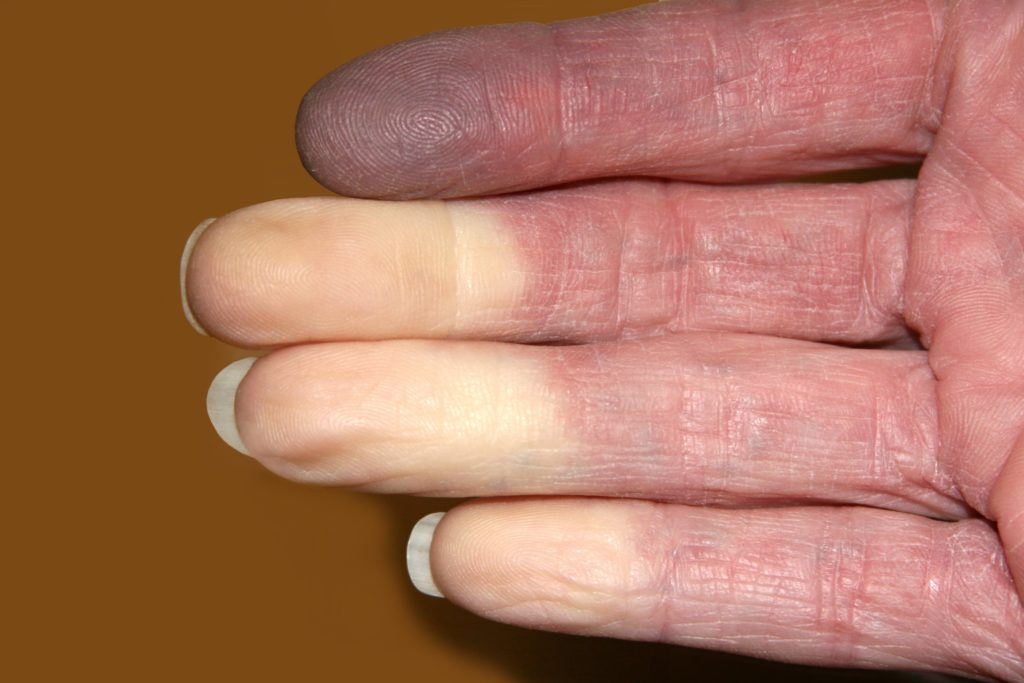When temperatures drop, we do everything we can to stay warm— turn the heat up, grab our heaviest blankets, and remember to dress in layers, layers, layers! But for people who have Raynaud’s syndrome, keeping hands and feet warm in the winter is an even greater challenge.
UVA Health is one of the first hospitals in the country to offer a revolutionary treatment technique for severe Raynaud’s syndrome. Image-guided botox injections performed by radiologists can help fight against the symptoms of Raynaud’s disease for up to 6 months. Continue reading to learn more about Raynaud’s syndrome, and how this safe, effective procedure helps blood circulate properly, keeping fingers and toes warm.
Article Reviewed by Dr. Michael Perry and Dr. Jennifer Pierce
What is Raynaud’s Syndrome?
Raynaud’s syndrome, also called Raynaud’s disease, is a disorder that affects the circulation in the extremities of the body. People with Raynaud’s have blood vessels (usually in the fingers or toes) that overreact to cold temperatures or emotional stress. Of course, it’s normal to experience some cold or red fingers and toes in low temperatures, but Raynaud’s is a more serious condition. This disease is more common among people living in colder climates, and usually affects women more than men.
When your body is cold, it tries to conserve heat by slowing down blood flow to the farthest points in your body. The network of smaller arteries that function to carry blood to these extremities get narrower to keep the body’s blood closer to the core and to protect all of your most important organs. When arteries and blood vessels shrink and temporarily limit blood flow, this is called a vasospasm. Doctors have observed that in people who suffer with Raynaud’s disease, the arteries shrink more and faster than normal, but they still are not exactly sure why.
What are the symptoms of Raynaud’s?
A Raynaud’s attack usually happens when someone is outside in low temperatures, touches something cold, or is under some kind of stress. During an attack, the skin on the fingers or toes may first turn completely white. You can often see a distinct line of color change between the white skin of the fingertips or toes, and the pinkish skin of the rest of the hand or foot where blood is circulating normally. Next, the fingers may turn blue and feel extremely cold or numb.

If the person changes their environment or begins to warm their fingers or toes, the affected areas of the body may swell, turn red, tingle, throb, or sting. This can be a painful process for Raynaud’s sufferers.
Some people who suffer with mild Raynaud’s syndrome may be able to decrease their symptoms by making adjustments to their lifestyle habits. This may include limiting exposure to cold as much as possible, always wearing warm socks and gloves, purchasing electric or chemical hand warmers, avoiding using tools that vibrate, quitting smoking, or taking blood pressure medications in the winter that help improve circulation. However, some people may have more severe cases of Raynaud’s disease that require looking at further treatment with a doctor.
Severe symptoms of Raynaud’s disease include:
- Frequent Raynaud’s attacks
- Digits that are continually purple
- Skin ulcers that form on the affected fingers and toes
- Constant throbbing and pain
- Dying tissue
How Image-Guided Botox Treats Raynaud’s Disease
For some time now, Botox injections have been performed as a treatment for severe Raynaud’s syndrome. But at UVA Health, specially trained musculoskeletal radiologists now use ultrasound-guidance as a new technique for these injections, making the procedure more precise while attempting to reduce the chances of complications.
Botox is actually a brand name of a toxin produced by the bacterium Clostridium botulinum. When injected into the hands or feet of patients with Raynaud’s disease, it acts to decrease the shrinkage of blood vessels which may help heal skin ulcers and lessen the painful symptoms associated with this disorder.
When the procedure is performed using the traditional approach (or without image guidance), there have been reported cases where Botox is injected or spreads into the nearby muscles in the hand, which can cause hand weakness for up to 6 weeks. At UVA Radiology and Medical Imaging, we use radiation-free ultrasound guidance to directly visualize the tissues of the hand and precisely inject a concentrated dose of Botox next to the affected arteries and away from the muscles.
Local anesthetic (Lidocaine) is first injected next to nerves in the forearm to minimize any pain associated with Botox injections. In total, the procedure takes only about 1 hour to treat both hands or both feet. Patients have found improvement in symptoms of Raynaud’s syndrome for up to 6 months after their Botox injections. This safe, relatively simple procedure is revolutionizing treatment for Raynaud’s disease.
Treat Your Cold Fingers and Toes at UVA Health
If you or a loved one is dealing with severe symptoms of known or suspected Raynaud’s Disease, ask you care provider about image-guided Botox injections performed by UVA Radiologists. Contact the UVA Hand Center at 434.982.4263 to schedule a consultation with Dr. Brent DeGeorge. Or contact UVA Musculoskeletal Radiology directly at 434.243.0391.
Learn more about pain injections performed by UVA Radiologists by clicking here.



